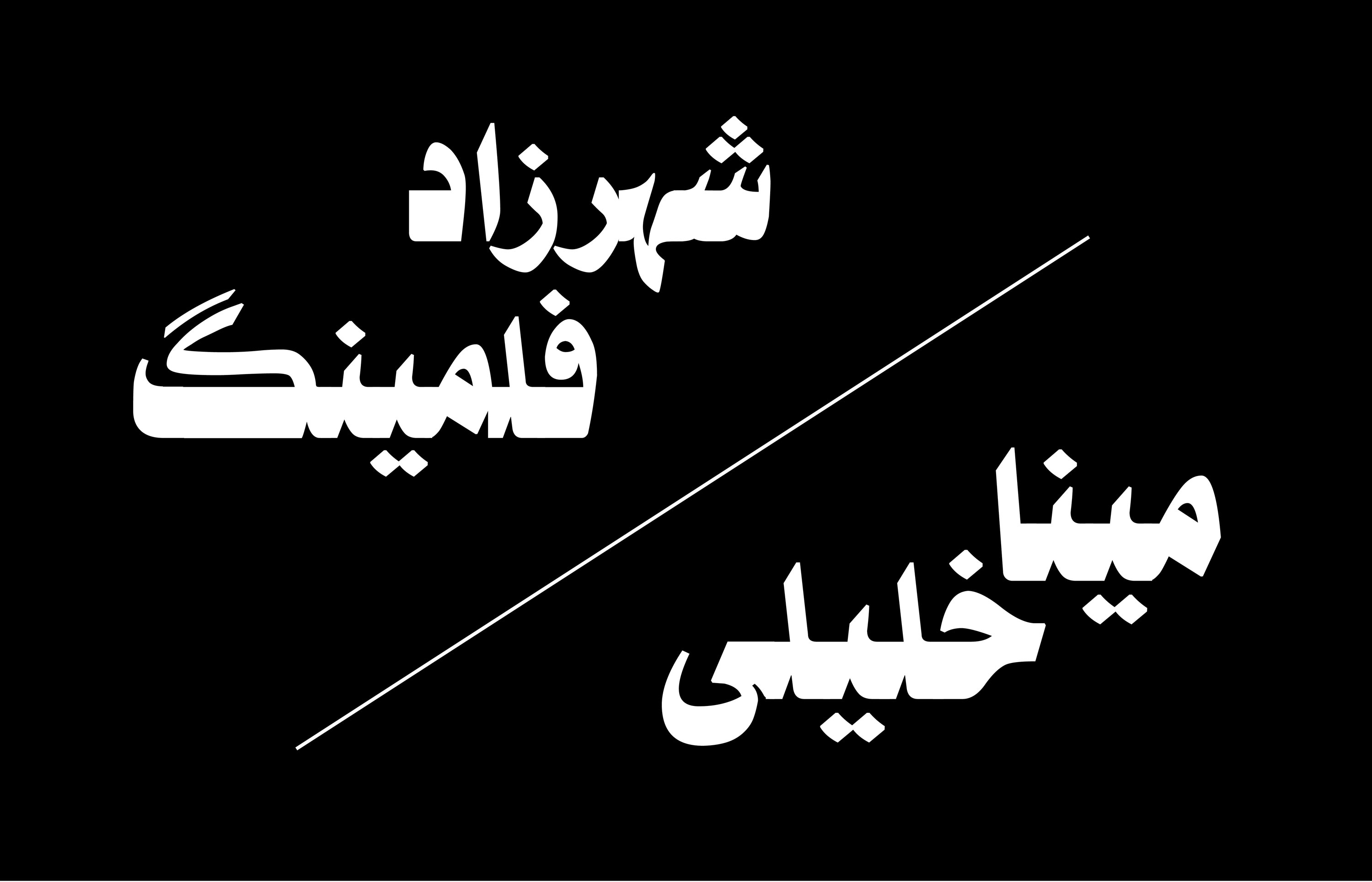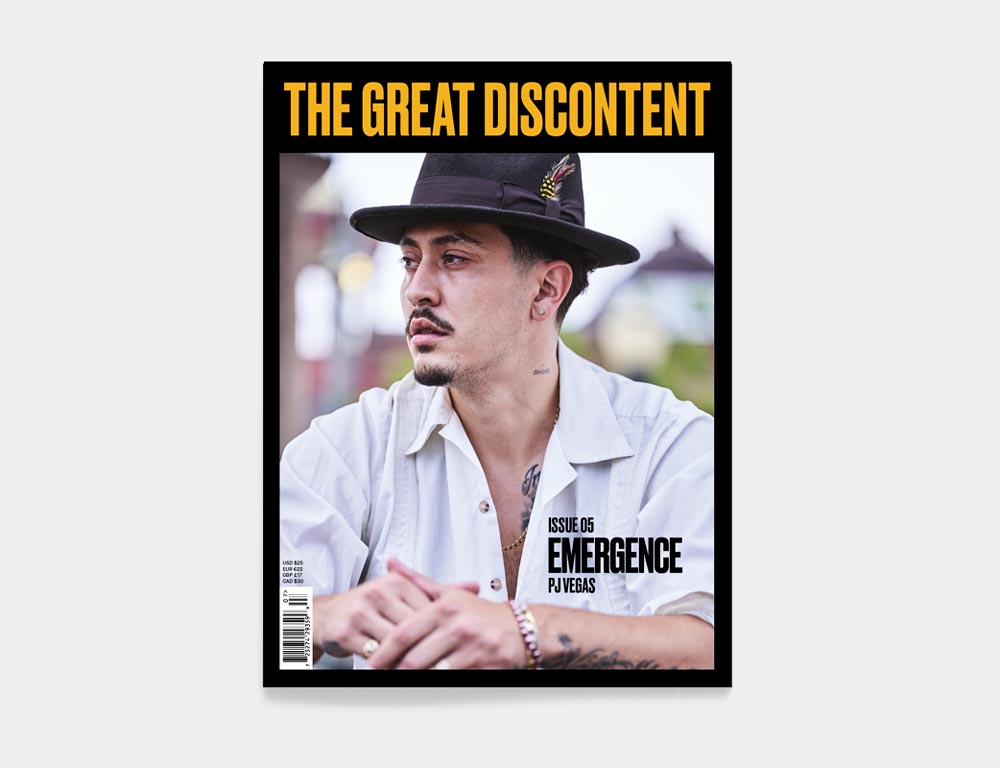
Emergence Issue: TGD's fifth issue features a dynamic group of 15 creators who are deeply committed to addressing systematic challenges in their communities through creativity and emerging ideologies. Buy Now
Meena, can you share a little bit about where you grew up and how that shaped your path?
Meena: I was born in Washington, DC, and raised six minutes away in Alexandria, Virginia, just outside George Washington’s plantation, Mount Vernon. My mother worked on Capitol Hill for 42 years before retiring. My father is an Iranian immigrant who owned a pork barbecue restaurant. I grew up around what you would consider a very mixed pot of folks from different types of backgrounds. I went through the Fairfax County Public School system along with a lot of politicians’ children, a lot of refugee children.
I could hop on the Metro anytime and go to the 9:30 Club on V Street and be around for Fugazi or They Might Be Giants or the Murder City Devils—anybody from Dischord Records. I was coming up at that particular time, and that influenced me a great deal to watch and be part of that scene.
As a young person, I was always interested in visual art and music, and that informed a lot of my education. Eventually, I saw myself sort of rebelling against the assumed or imposed presumptions about who I must be, as a person with the name Meena Khalili.
Sheharazad, your origin story is a little bit different, but it takes you to the same geographic location, right?
Sheharazad: It does. That was one of the miraculous things when Meena and I first met—there was this weird sort of instant connection.
I was born in Tehran just before the revolution. I came to the United States in the mid-’80s, with my mother, to seek refuge from the Iranian Revolution and the war with Iraq. My father wasn’t able to join us immediately, so we lived with my uncle, grandmother, and cousins—a very traditional immigrant story, where we lived in one house together.I remember my cousin Rebecca, who was born in America and could only speak English—of course, I could only speak Farsi—we had found a way of communicating with one another in this sort of secret language that we fully understood. We would stand at our bedroom windows and communicate with one another. It never occurs to you, as five-year-olds, that you’re communicating in this way that adults would never, ever be able to decipher, but to you, it’s completely natural, and it involved a lot of drawing and creativity. Then, just like Meena, we ended up right outside DC, in that same school district. My father had finally come to America. Reston is a planned community built in the ‘60s around a lake.
Midcentury modernism isn’t something that is very much a part of the East Coast environment, but Reston was—down to the minimal, brutalist design of the playgrounds. This was the first time my imagination opened up into understanding that the world had these possibilities. We moved around every year up until I went to high school, but Reston is where I finally felt like America was home.
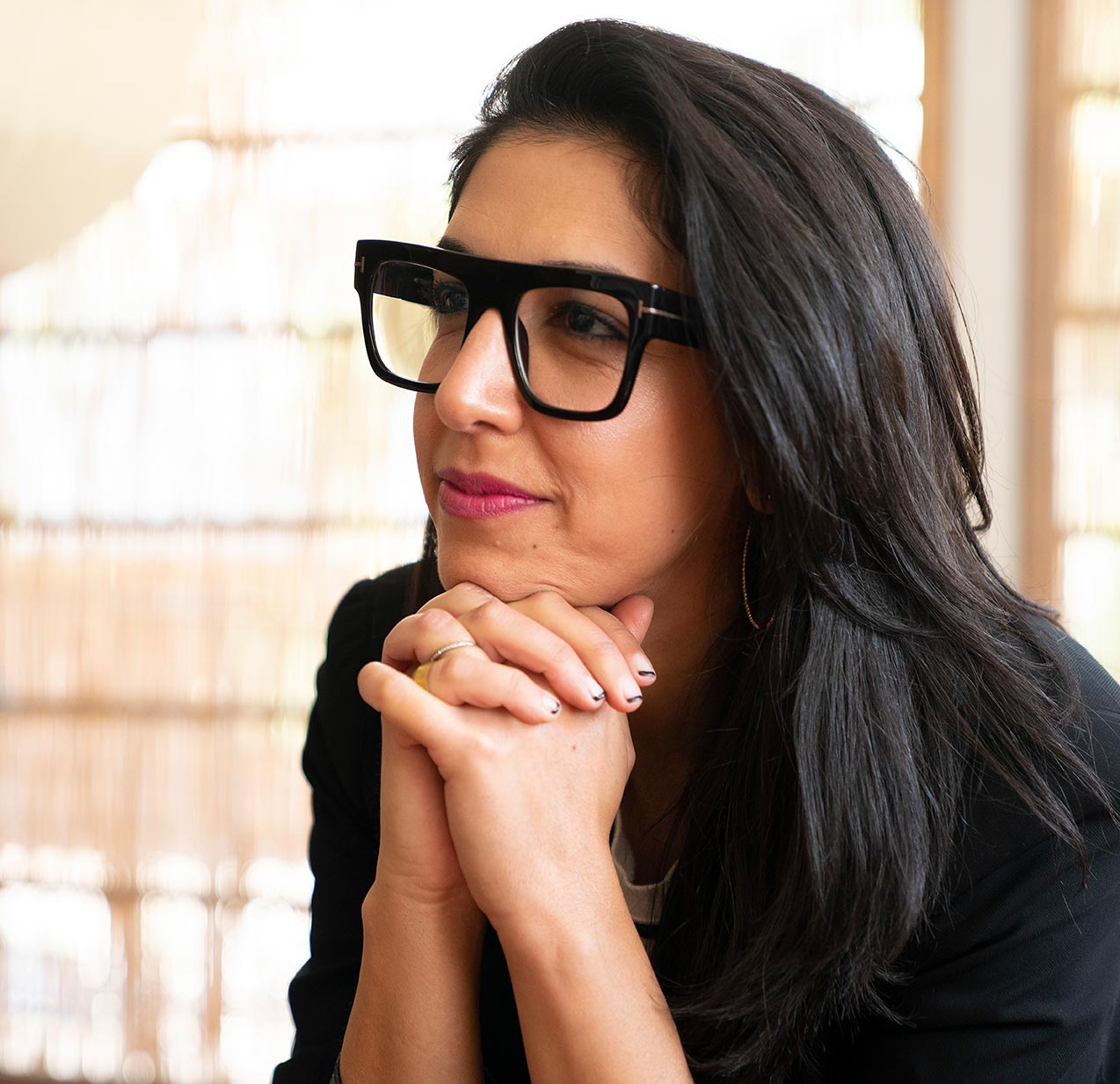
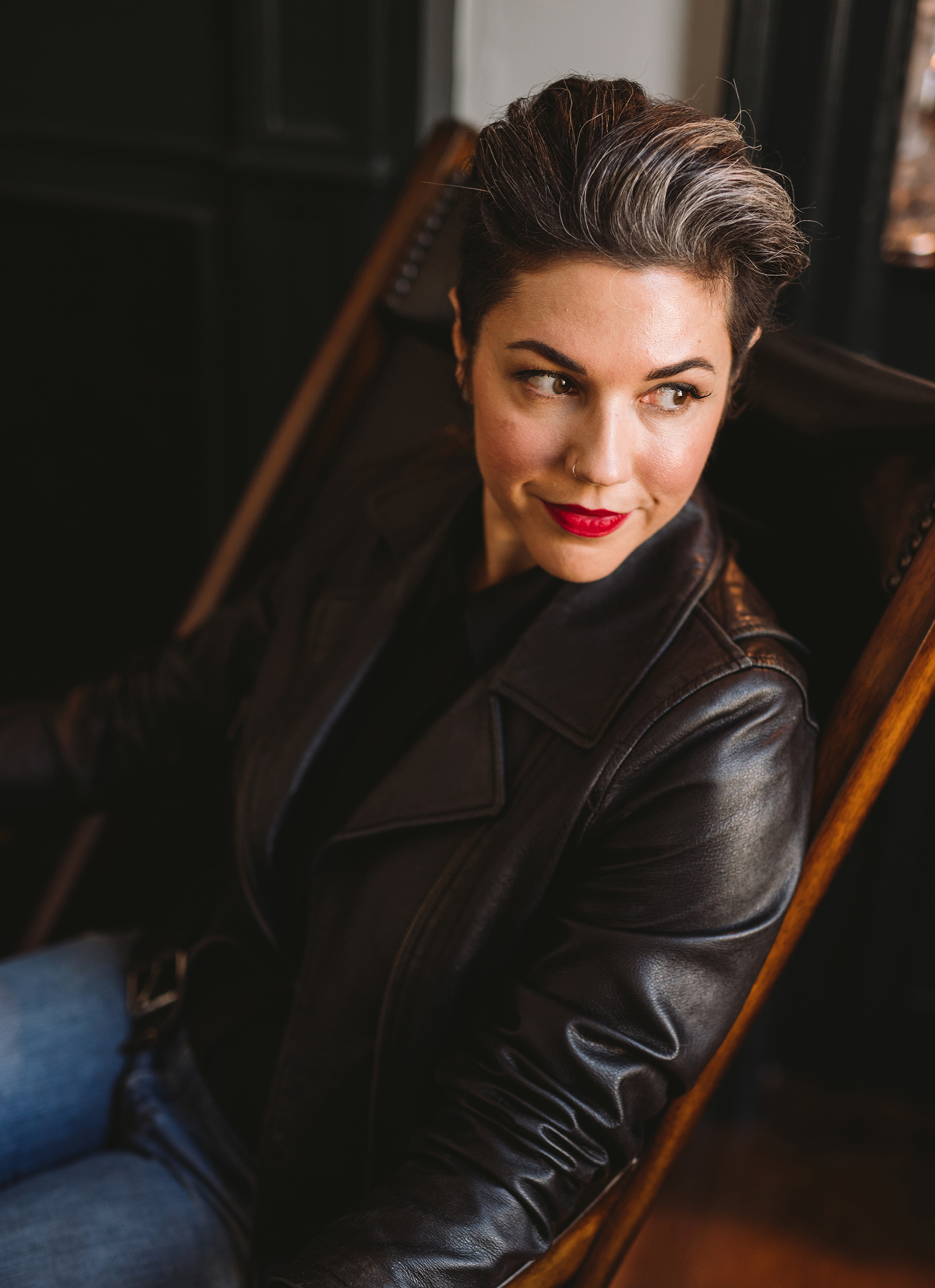
Were you creative when you were young? And if so, how did place influence your emergence as creative beings?
Meena: I think it starts early, right? At the age of four, I told my mother I wanted to learn how to read music. So I started learning the language of music, and that led to 16 years of classical piano, which led to jazz vocal work, which led to performance work. In college I decided I didn’t want to do performing arts, I wanted to do visual arts.
Sheharazad: I never considered myself a creative child. But my mom and dad remember me doing all kinds of strange crafts and performances. I was an only child up until my sister was born, when I was nearly 10. When you’re an only child, you spend a lot of time creating your own world. I didn’t have a lot of exposure to the arts in terms of curriculum. None of my parents’ friends were artists, so it never occurred to me until I was in college that the arts were an area where you could have a career. It’s important for me to make sure young people understand that there are so many creative pathways they can pursue.
Meena: I’ve realized two things just listening to you, Sheharazad. One, that my failed attempt to learn Farsi with my father may have had something to do with me telling my mother that I wanted to learn how to read music. What also may have influenced my aspirations was that my father was on the phone speaking very loud, right? Because you’re speaking across the world. [Laughs]
Sheharazad: A hundred percent louder because it has to travel that distance.
Meena: [Laughs] The second thing that I realized was how spoiled rotten I was living in DC with free museums and all of that access to music. Taking the Yellow Line to the National Gallery or just walking around the sculpture gardens or going to see bands.
There’s something about that rhythmic sound and the rocking back and forth in trains that influenced the next moment of seeing artwork or going to a show. They were always married, those rhythmic sounds, and then the visual—I’m trying to create artwork with a pulse. My biggest attempt is to create work that captures that rhythm and feels like it’s moving. That’s the place I go in my mind when I’m trying to be creative.
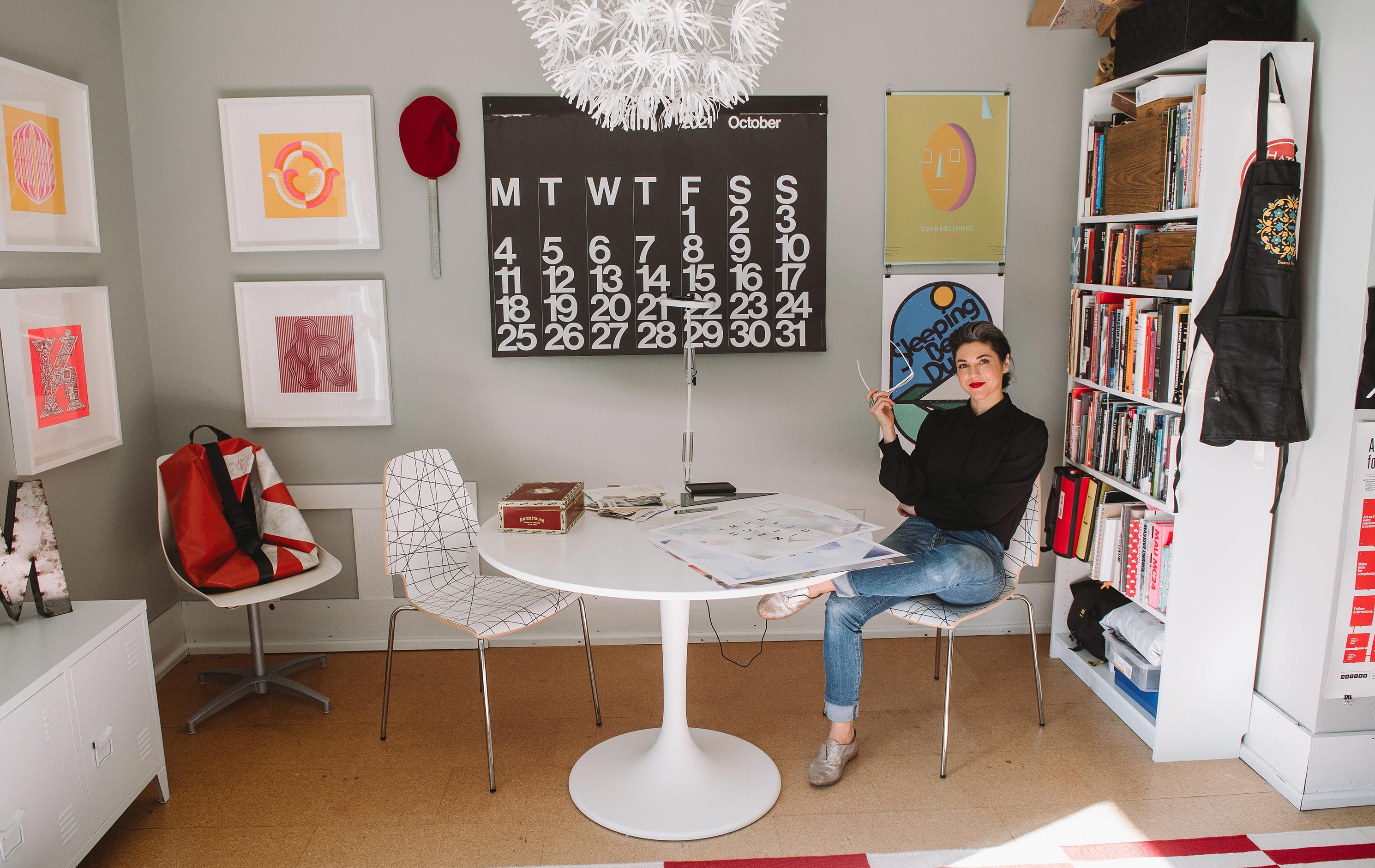
From your perspectives, how can we create spaces that truly hold up reflections of identity and experience in a way that provides a spectrum of examples and modeling?
Meena: It’s important for those who are in a position of making decisions to be aware and as understanding as possible of the most vulnerable people in the room, so to speak. We talk about educators and who “gets to” teach, right? Being able to make decisions within an organization is a position of power. I don’t think any single organization can be perfect. I think it’s really important to keep trying.
Sheharazad: I can’t point to any organization that I feel has it right. I presume that the reason why we are both involved is our intention to help get it closer to right. Or at least help get it closer to understanding the nuances and the differences between right and wrong as it relates to our past and our future.
I’m seeing the same challenges across many organizations, and the ones that are progressing are the ones that are allowing a diversity of voices to come together and offer perspectives, have that discourse, take that time, create that space in order to take steps to make change.
I don’t have the answers for what the next steps are, but I know that I’m showing up to roll up sleeves and help and do my part, and to learn from those showing up alongside me.
How would you describe what your creative lifestyle looks like—the things that are inspiring you in work and life?
Sheharazad: I became even more of a collector of inspiration as part of being in union with my husband, Ron, who is also a designer. All of a sudden our collections started to merge and they grew. There was a small area of overlap, but we were interested in different things and brought one another into those spaces. It’s opened up my world.
We go to yard sales and thrift stores and estate sales. We’re always looking for books and art from the past—exploring and learning through the objects that we find and curating our home to include them as artifacts from the experience. I stay creative through curiosity and urban exploration. Los Angeles is endlessly opening up to me. There are 88 municipalities; no two areas are the same. Living in Los Angeles, it feels like there are no boundaries. Like you just have to have the dream and work toward it and then you become it. I really believe in that.
I feel like it’s my duty to think creatively and not take anything for granted because my parents gave up everything to get us here and to give me this. Sometimes it feels like a heavy burden, but most times it feels like an opportunity. That is what sparks my creativity, my inspiration, my joys.
“Living in Los Angeles, it feels like there are no boundaries. Like you just have to have the dream and work toward it and then you become it. I really believe in that. I feel like it’s my duty to think creatively and not take anything for granted because my parents gave up everything to get us here and to give me this.”
Meena, do you feel any responsibilities as a creative because you have that unique perspective of the world?
Meena: Yes. I feel many responsibilities [laughs] as a creative educator who runs a studio practice and puts work out there. As a creative raising a child. I feel a lot of responsibility for the work that I do and the lens through which I educate folks about that work. Lesley-Ann Noel has this wonderful work called the Designer’s Critical Alphabet, a series of cards that asks questions about intersectionality and neocolonialism.
I was inspired by one of my first creative directors, Andy Stefanovich, to look at as much as you possibly can and reflect on it, synthesize, write all the time. If you’re not good at writing, practice. When I teach, my students write every week for me. It’s not fun for most of them. But if we are simply creating output and then we’re not looking back at the work that we’re doing and thinking about how it worked, how it didn’t work, who it served, who it did not serve, and so forth, then we are not able to allow ourselves that space to grow.
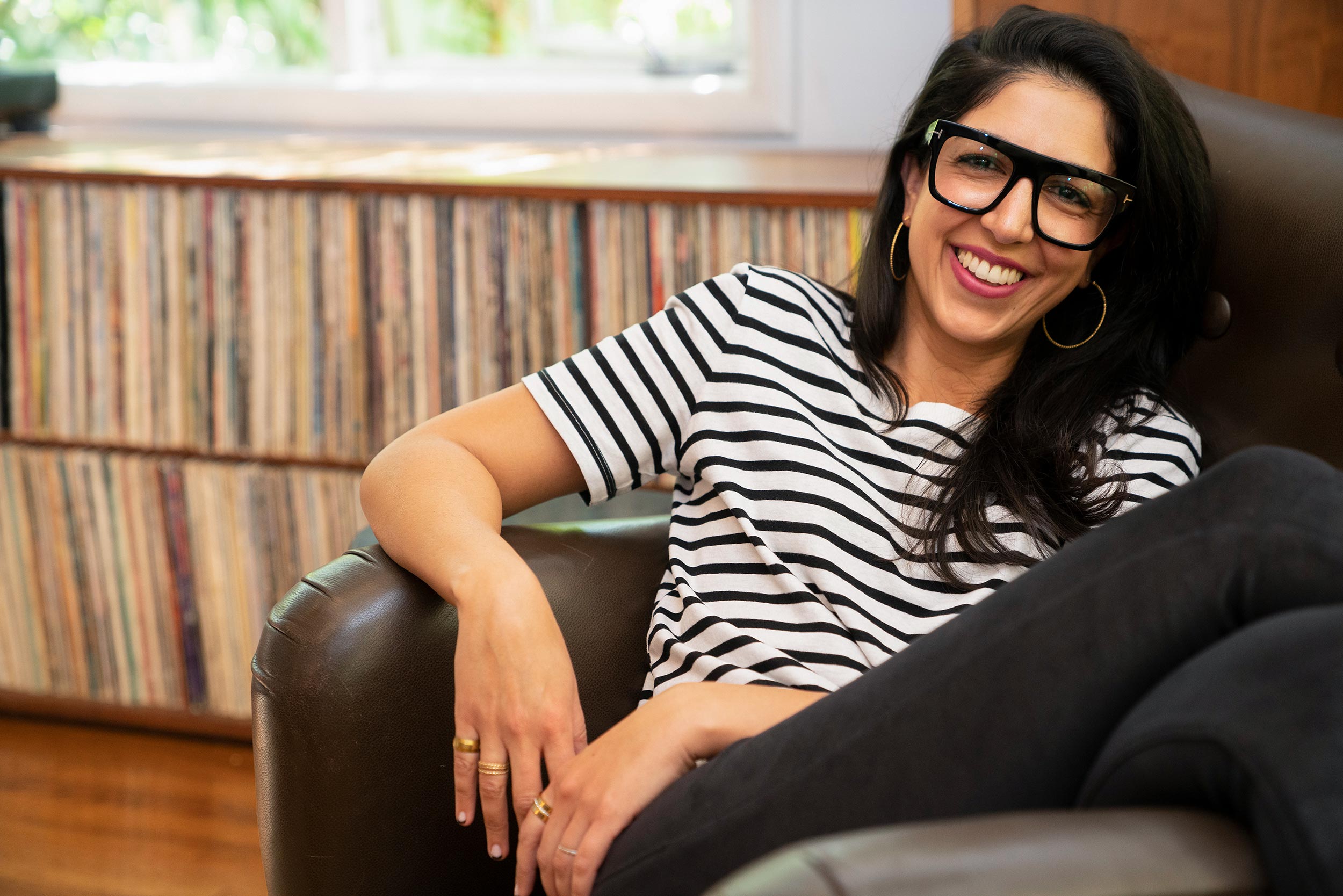
Sheharazad, as someone who didn’t necessarily self-identify as creative yet now leads and educates in these very creative spaces, what was the career discovery journey like for you?
Sheharazad: I learned English through music and television. Certainly, I was in ESL in school, but being immersed in those two things was how it really all came together for me.
The first time I started to get an inkling that there was a more creative pathway was watching the show Bewitched. I remember Darrin having his boards and going to client presentations. I know that [his career in advertising] was a secondary subplot to the wacky high jinks, but I was completely fixated on it.
Who’s the Boss? was also a hit at the time. It really sealed the deal for me that Angela Bower was not only an advertising executive, but she was the boss. She left her household every day to run a company, and she also had those boards and the ideas and was doing the client pitches.
That’s when I told my parents that I wanted to go into advertising and, like Angela, be the boss.
As educators, how do you articulate to students the opportunities that a creative path presents? How do we open up the creative pipeline so that more youth see the possibilities?
Meena: I hosted an event for my students with Climate Designers, and in his talk, Marc O’Brien said: “Design solves business problems. And in terms of innovation, design comes right after technology.” That positions design near the top of the chain, right? Design didn’t used to have a seat at the table. Now, design is listening to the discovery conversations so that in the boardroom, design is able to help make informed decisions for businesses.
The landscape of the work that we do has broadened and evolved. We’re talking about different wells, essentially, in the landscape of design and the various practices. We are looking at a field that is not just transforming, but it’s transformative for those who understand the importance of it.
Sheharazad: I live on a street with the largest public high school in Los Angeles. Every morning, I see students walking to school, and I’m looking at each of them like, “Which one of you needs to know that you can do this?”
When I worked at Otis College of Art and Design, we put together a virtual panel series called Creative Futures to give pre-college students a chance to learn about all the ways you can pursue a career in the creative sector. We invited all the high school students from one of the largest public school systems in the country to join for free, and we had working designers come to speak to them about their creative journeys. We had a designer who was in charge of designing a part of the space suits for the astronauts going on test flights for SpaceX. We had the head UX designer for Hulu’s interface.
Whether I’m inspiring a student or maybe giving a little bit of a sense of relief to their parents who are like: “My son’s going to go and be an artist? What does that mean?” It was reason enough for me to really pour my heart into it.
Meena: One of the big things that I’ve been working on is to broaden the definition of “educator.” Who gets to teach? Looking at people like Jacinda Walker from designExplorr and the work that she’s doing: how can we bridge that moment between K-12 and higher ed? How can we make that bridge more clearly defined for all who are interested in walking across it?
I never saw a bridge. There’s so much gatekeeping. When you’re a first-generation college student like me, you might not be aware of what opportunities are available to you down the line.
When I was an undergrad at VCU [Virginia Commonwealth University] School of the Arts, somebody told me to go to this comic book store—Velocity Comics—in Richmond on Grace Street. I walked in and there was this graphic novel called Persepolis [about life in pre- and post-revolutionary Iran and then in Europe]. Marjane Satrapi was extremely formative for me. When you’re in your early 20s and you see somebody with a name that sounds like yours, and they look a little like you, there’s something empowering about that.

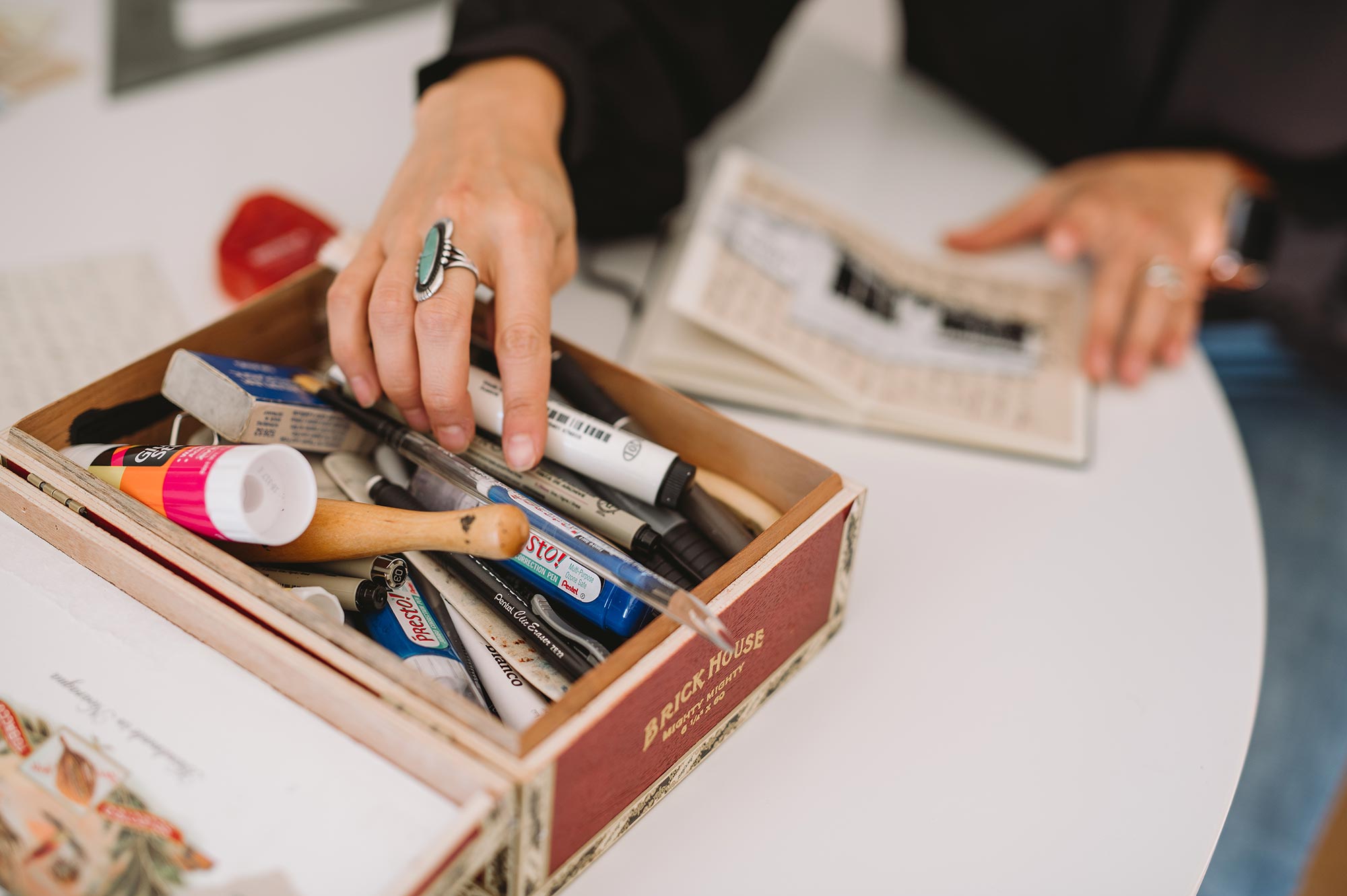
How do you stay creative? What is the practice and process and maybe even ritual for you?
Meena: I met my husband when we were later in our creative careers and already established. With that came this wonderful mutual understanding of how the compulsion to create is something we live with—for better or worse. [Laughs]
My partner, Brent Dedas, is a fine artist who works with honeybees. It is a very different type of process—field, even—in terms of creativity. With that, I get to broaden my understanding of creativity and what it can look like. His shared experience helped me to understand more about myself as a creative individual and as a maker, so that my work has expanded.
I started this project called The Drawn Daily when we moved to Louisville, and I was itching for a way to learn about my new city, a city that he was born and raised in. I thought, “What if I drew it once a day, every day for a year?” And he said, “Every city wants to be complimented.” Ever since then, I’ve been drawing whatever city I live in, wherever I am. He helped me to frame that daily practice. It’s an ode, it’s a love story. Not every drawing is fabulous, but that’s not the point. The point is to be consistently creating.
When it comes to my work that is more multimodal, my projection-mapped work or my augmented reality work, that is specific to my personal experience as an Iranian American—passing language. The visuals of that have a lot to do with watching Persian music videos growing up and the way that the TV used to glitch. My moving image work is inspired by those moments of trying to parse what’s happening through a very glitched screen or portal.
Both practices have developed because I’m within a partnership that understands the need to curate and to work those muscles within your creative practice.
Meena, one of your artist statements reflected this slow dissolution of Middle Eastern heritage, as the daughter of an Iranian and an American. Would you talk a little bit about that idea of cultural entropy?
Meena: My father served in the Iranian Air Force. He was a physics instructor at one time, so when I was looking for ways to work through my concepts, I decided to borrow the second law of thermodynamics. Entropy is the transformation of something from one state to another.
I know about my Iranian family through stories that my father tells me. And when he passes, I will lose all that. It’s a sobering and upsetting reality. A lot of this work has to do with getting my father to tell me stories and transcribing those stories—not from language to language, but in a way that shows how fragile they are. He’s the youngest of eight children, so a lot of this information about my Iranian family will go with my father. All the recipes, all the stories, all my cultural heritage is being held on by a thread. I am working on ways to visualize that impermanence.
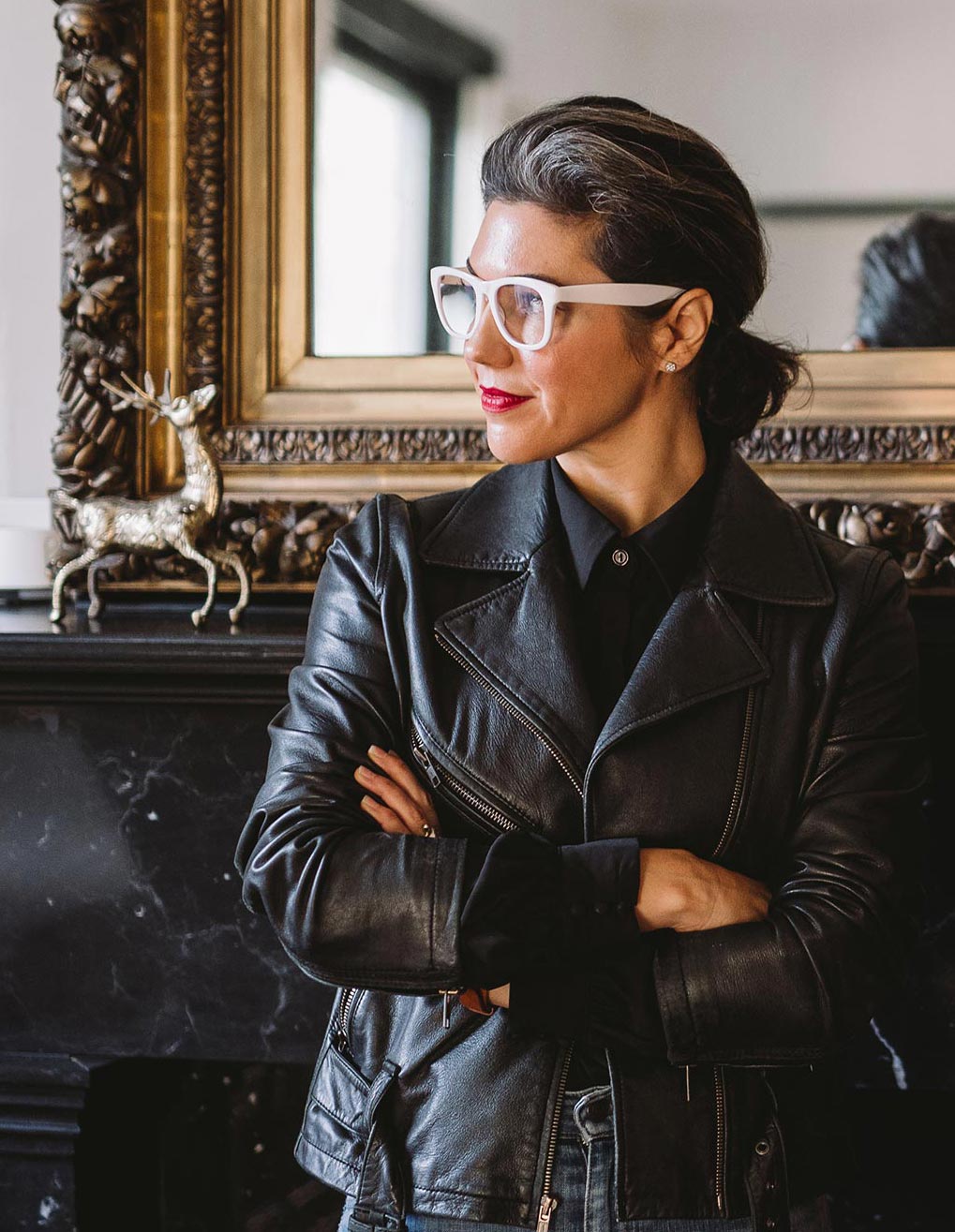
How have those concepts played on your career, Sheharazad, having come to the US at such a young age? Is it different for you, having memories of the specific moment of departure?
Sheharazad: This is a tough thing to talk about. There is so much emotion tied to the reasons why families like mine and Meena’s are here. My father said to me recently that moving to America was the greatest thing he ever did and also the worst thing he ever did.
I feel a deep sense of responsibility being here and being away from the family that I still have in Iran. I’m conscious of the opportunities that I was afforded, and of those who were left behind. With what’s going on in Afghanistan, Iran, and other parts of the world today, there are so many young people who have never lived a day with true freedom.
My drive comes from that sense of responsibility. If there’s anything that I’ve done in my life that is positive, it is 100 percent for those that are living that “Other” experience—and also for my family, who sacrificed to make sure that I had the opportunity to have a very different lived experience.
Even as a seven-year-old visiting, I felt this connection to Los Angeles. I was on Wilshire Boulevard, and I was like: “This is home. This is it.” As an adult, I understand that it reminded me of the place that I came from, both in terms of the way it looked—the topography—but even the typography. And also the smell. In Tehran and LA, there’s this smell, it’s a mix of petrol and night-blooming jasmine, and they come together in this perfect confluence of city and nature. It makes me feel whole. And so I declared to my mom and dad, “When I grow up, I’m moving here.” And, dammit, I did it. And I have them to thank for giving me the chance to.
